
- HOME >>
- Our Actions
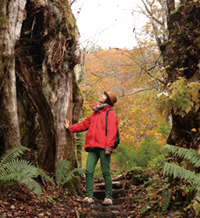
"What is the name of this plant?" "How old is this tree?" "What kind of nut is this?" When walking through nature, there are many things which cannot be seen within our daily life and they awake our curiosity. Expanding our knowledge makes us happy. However, every step that we take through nature exposes use to changing aromas, colors, leaves, the texture of earth beneath our feet and the sky seen through leaves. Such sensations exceed knowledge and strike directly into our hearts.
"Let's Walk in the Forest of North Hida! Experiencing the Forest of North Hida, Gifu Prefecture"--This website allows visitors to feel the gentleness and nobility of forests in the North Hida area. If you feel moved upon viewing our website, then please come to North Hida and fully indulge in wonders through all of your five senses. The gentle nature will resonate with your own gentle feelings and speak something important to you.
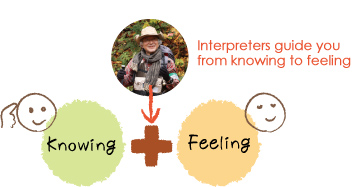
Interpreters (forest guides) will help you to understand the message of nature and have a more enjoyable experience. Interpreters have extensively studied and experienced nature themselves.
In addition to fulfilling your desire to know, interpreters will provide you with many, many opportunities to experience natural wonders through your five senses while walking together through the forest.
Interpreters are a bridge connecting you and nature.
Protecting mountain trails in Amou Prefectural Natural Park
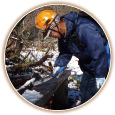 |
Iwasa TorioThe gentleness of North Hida nature comes from the gentleness of people who protect our forests
Protecting mountain trails in Amou Prefectural Natural Park
If metal bolts are used to secure wooden stairs on mountain trails, the wood rots away and sometimes only the bolts remain. It is very dangerous if someone trips over such a bolt. Therefore, we use stakes made from chestnut trees logged locally. Making use of the time that trails are closed due to snow, we make about 1,200 or 1,300 stakes every year. If we step on a tree root while walking, we feel as if we have been stepped on ourselves.
Sunada ShigenoriStakes made from chestnut are quite heavy and difficult to carry up the mountain all at once. A maximum of about 30 stakes can be carried at one time. Even if 60 stakes are carried, only 30 stairs can be secured because two stakes are required for each stair. While being careful not to damage tree roots, we actually walk the trail ourselves to make sure that descending is not hard on the knees. We will never forget how a blind person who once climbed our mountain together with a volunteer remarked that "the well-maintained trails made it possible for me to climb." |
|---|---|
 |
Interpreters teach how to interact with nature
 |
Shida NarioI want to pass down how residents of Hida have coexisted with the forests. Until about 1945, a tradition called fuu existed. This tradition took place when maitake mushrooms first appeared in the forest each year. At that time, the first person to discover the mushrooms would make a mark. For example, they would use small branches to make a cross. This mark was known as fuu. Afterwards, people who saw the fuu would not take home the marked mushrooms. 7 or 8 days later, the maitake mushrooms would have grown lush and exuded a rich aroma. They would also be capable of releasing spores. In the past residents shared the blessings of the forests and mountains without unnecessary disagreements. This important way of life has been lost in today's world. |
|---|---|
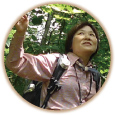 |
Kageyama SetsukoIn the forest, I found a spruce tree bud that was about 1 centimeter big on top of a fallen tree. Upon seeing how such a small plant works so hard to spread its roots, even children are sure to recognize the extremely long time required by nature and the cycle of life. In turn, they will innately feel the value of life. Some people may tread upon and destroy such nature when entering the forest to harvest mountain vegetables. However, if more people work to protect the forest, then I think it will naturally become difficult for people who don't value nature to enter these woods. |
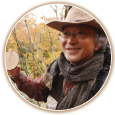 |
Iwasa KatsumiI believe that the role of an interpreter is to connect the forest with people by representing and conveying the messages of trees, flowers and animals which cannot speak. Furthermore, another role is to connect people with other people. It makes me so happy to hear people within my group becoming friends and making plans such as to walk through the forest again in autumn. When conducting guided tours, I hope that such friendships will increase the fellowship of people who love nature. Also, each forest possesses its own special appeal. I want to be an interpreter who possesses the sensitivity to convey such appeal and share the wonder of the forest with people in my walking group. |
















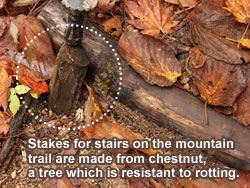 We shed tears when a large beech tree withers and dies. Therefore, without placing a burden on tree roots or people, we maintain our forests in a way that elicits the beauty of nature and creates a feeling of warmth.
We shed tears when a large beech tree withers and dies. Therefore, without placing a burden on tree roots or people, we maintain our forests in a way that elicits the beauty of nature and creates a feeling of warmth.









